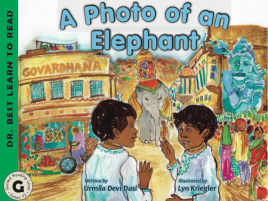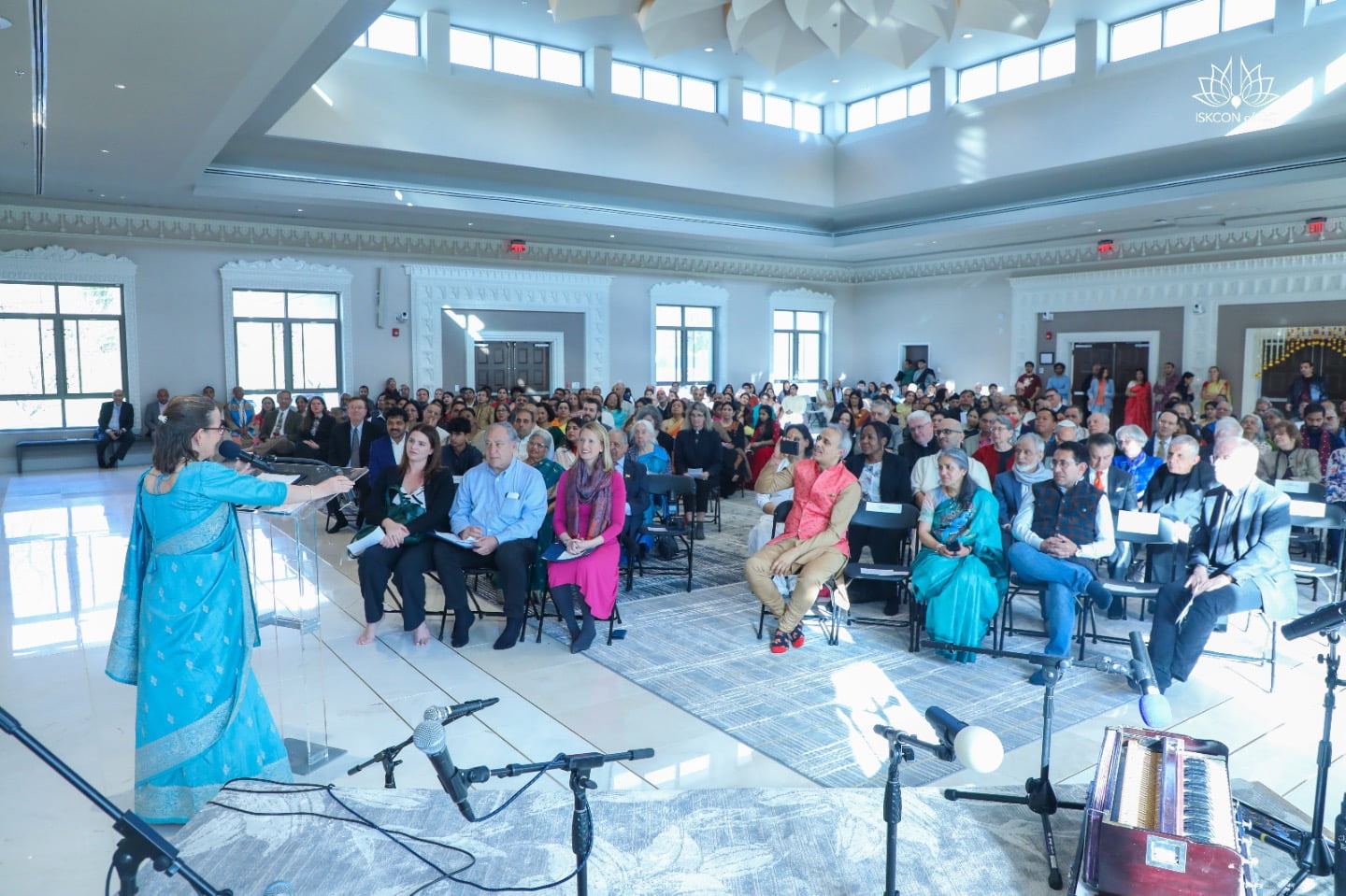Forthcoming Children’s Readers to Combine Quality and Krishna
By Madhava Smullen | Jul 10, 2010

A brand new 84-book series to be released this September promises to teach children how to read English in a Krishna-centered way, while utilizing top-quality professional materials and teaching methods. And it has more than a few surprises up its sleeve.
Dr. Best Learn to Read took over three years to develop and involved over 200—mostly voluntary—contributors, including fifteen professional teachers and educators, some leaders in their fields.
“Dedicated efforts were made in the early days of ISKCON to develop educational materials,” says project manager Urmila Dasi (Dr. Edith E. Best), an educator with more than thirty years of experience in both primary and secondary education and teacher training. “But none were on a professional level. So when myself and ISKCON educator Sita Rama Dasa from London started this project back in August 2007, we wanted it to be professional quality on every level—from the teaching methods to the paper quality and illustrations.”
The series uses international methods of teaching reading that have been widely tested in the US, UK, Canada, Australia and New Zealand and found to be successful for decades, including Britain’s Book Bands, New Zealand’s Reading Recovery, and America’s Fountas and Pinnelli.
But the most distinguishing trait of Dr. Best Learn to Read is that it is the first literacy program in the world to incorporate both whole language and phonics systems, as well as instructions for teaching each method, making it extremely flexible.
“Generally proponents of whole language and proponents of phonics criticize each other and argue that only their method works,” Urmila says. “But we decided to combine the two, so that everybody could use our reading program no matter what system they favored. At first, the experts told us it was impossible. But now they’re saying, you did it! That was very exciting.”
The series also aims high with its content, featuring a wide variety of stories. Of the forty-two full-color reading books, one group of seven focuses on Lord Krishna’s pastimes. Another group brings characters from the Srimad-Bhagavatam and other scriptures to life, including King Bharat and King Pariksit. Another tells traditional moral fables that ISKCON founder Srila Prabhupada used to illustrate philosophical points, such as “The Priest and The Cobbler” and “Be A Mouse.”
One series follows a family that lives in the sacred town of Govardhana, India, as they take care of their cow and observe different Krishna conscious festivals.
Another is about a family in the West that visit a Krishna temple, serve the Deities there, and worship their own Deities at home. “There are also what I call spiritual fables,” says Urmila. “One book is about the Ratha Yatra cart festival, another is about celebrating Holi, and two are photography books about farming with oxen and taking care of cows.”
Every book in the series, meanwhile, includes vibrant, colorful illustrations by top artists including New Zealand illustrator Lyn Kriegler—author of seventy-five books published by Penguin and Scholastic—and a number of professional animators based in China.
Probably the most unique selling point of the series, however—and one which parents and teachers are unlikely to be expecting—is that they can talk. “We use a system called TalkingPEN, which is used by only a handful of publishers,” says Urmila. “You touch each page with a computerized pen that has a speaker built into it, and it picks up an almost invisible bar code and reads the page out to you.”
And there are no synthesized drones here—every word is read by devotee volunteers from around the world. “Mantra Lingua, our publishing company, advised us to select readers who really had a feel for the material,” Urmila explains. “That way, their emotion for the stories comes through in their voice, making it more gripping.”
And English isn’t the only language to listen in. By touching one of a row of circles on the book with the TalkingPEN, you can hear each page in no less than twenty-five languages, including Hindi, Bengali, Gujarati, Russian, Italian, Spanish, French, Afrikaans, Thai, Japanese, and Chinese. As well as allowing children for whom English is a second language to hear the stories in their own tongue, this feature also gives all children exposure to a wide range of languages.
That’s still not all the TalkingPEN is capable of. Readers can also hunt for hidden audio in the illustrations to hear the characters speak. Touching a picture of Krishna breaking a pot of yoghurt, for instance, elicits a cry of, “Oh-oh! All the yoghurt’s spilling out!” while touching a picture of Radharani causes her to sing,
“Where is Krishna?” Readers can even touch the moon and listen to it say, “I hope Radharani can find Krishna.”
“You can also record your own voice into the characters, without interfering with the original audio,” Urmila adds. “So one child can record over all the Krishna spots, while another records over all the Mother Yashoda spots, and they can use the books as if they were a puppet show or drama. It makes the stories really come alive.”
To enrich children’s reading skills and comprehension, each of the forty-two full-color talking story books is accompanied by a black and white book with plenty of fun activities, as well as instructions for parents and teachers. Children can match sentences to pictures, fill out crossword puzzles, find homonyms in a poem, or create their own character poster.
Urmila hopes that such a Krishna-centered reading series will bring joy to those families that want their children to have a strictly spiritual curriculum. “My heart really goes out to those parents that are trying to homeschool, and don’t want to buy Mickey Mouse books for their kids,” she says. “There’s not much out there for them right now.”
She also hopes that Dr. Best Learn to Read will be embraced by ISKCON’s wider congregation, the Indian community, other Gaudiya Vaishnava groups outside of ISKCON, and other Vaishnava lines such as Sri Vaishnavas and the Vallabha Sampradaya.
But the series is also aimed at a broader audience. “While a few of the books mention philosophical points,” says Urmila, “For instance, the story of King Bharata discusses reincarnation—we mostly just tell the stories and allow the parents or teachers to use them as a springboard for whatever lesssons they want to teach, rather than incorporating them into the book.”
And so, a test printing of just six books are already being used for multi-cultural instruction in government schools in the UK. “They should be of interest to any of the general public that are interested in Indian culture, Eastern spirituality, or yoga and reincarnation,” Urmila says. “For example, we have one book promoting vegetarianism, which you wouldn’t find in existing children’s readers. Most other readers out there all have very materialistic themes and present a middle-class suburban lifestyle where God and spirituality are completely absent.”
The 84-book Dr. Best Learn to Read series will be released on Janmastami Day (September 1st) 2010, and will be available through the Internet directly from the publisher’s website, to avoid distributors’ costs and keep the price lower for customers.
“I hope that this will be just the beginning,” Urmila says. “From the early days of ISKCON, Srila Prabhupada wanted us to produce Krishna conscious curriculum materials. And I’m hoping that by seeing how we created this despite starting with no money, no manpower, and no infrastructure, more devotees will be inspired to create professional, high-quality, and educationally systematic programs for all ages, subjects, and languages.”
To purchase the Dr. Best Learn to Read series and to find out more, please visit www.illuminationeducation.com.
To help sponsor complete series for schools in India, or to find out more information about the series, please contact Urmila Edith Best through Facebook.












